|
Why is this goal important?
The Department is mandated under Chapter 363A, the state Human Rights Act,
to perform this function; it is central to our mission.
Employers, employment agencies, and labor organizations are prohibited from
discriminating against persons on the basis of, or requiring applicants to
provide information about, one's race, color, creed, religion, national
origin, sex, marital status, status with regard to public assistance,
disability, sexual orientation, local human rights commission activity, or
age. They may not discriminate in any aspect of employment, including
hiring, training, promotion, pay and benefits, conditions of
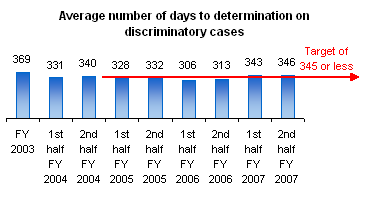 employment,
termination, or layoffs. Most charges of discrimination received by the
department are in the area of employment on the basis of age, sex, race or
disability. Employers of 15 or more are required to provide reasonable
accommodation for qualified employees and applicants who have disabilities. employment,
termination, or layoffs. Most charges of discrimination received by the
department are in the area of employment on the basis of age, sex, race or
disability. Employers of 15 or more are required to provide reasonable
accommodation for qualified employees and applicants who have disabilities.
Persons selling or leasing real property or housing may not steer people or
refuse to sell, rent or lease property because of one's race, color, creed,
religion, national origin, sex, marital status, status with regard to public
assistance, disability, sexual orientation, or in most cases, familial
status. Banks or other financial institutions may not refuse housing loans
or other financial assistance on these bases. Persons selling or leasing
real property or housing also may not refuse to reasonably accommodate
disabled persons by allowing reasonable modifications of rules and policies
and some structural modifications at the renter's expense and must allow a
renter's service animal.
Discrimination in public accommodations is prohibited on the basis of race,
color, creed, religion, disability, national origin, marital status, sexual
orientation or sex. Public accommodations include a business, accommodation,
entertainment, refreshment, recreation or transportation which offers,
sells, or makes available its goods, services, facilities, or privileges.
Public accommodations may not refuse to reasonably accommodate disabled
persons. Reasonable accommodation can include providing physical and program
access, use of trained service animals and removal of structural barriers.
State agencies and local government agencies may not discriminate against
any person in access, admission, use or benefits of public services because
of race, color, creed, religion, national origin, disability, sex, sexual
orientation or status with regard to public assistance or refuse to
reasonably accommodate disabled persons. Reasonable accommodation can
include providing physical and program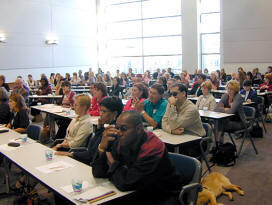 access, use of trained service
animals and removal of structural barriers. access, use of trained service
animals and removal of structural barriers.
Educational institutions may not discriminate in use of, or benefits from,
their programs or services because of race, color, creed, religion, national
origin, sex, age, marital status, status with regard to public assistance,
sexual orientation, or disability. An educational institution may not
exclude or expel a person on these bases, nor collect such information in a
manner, which identifies an applicant for admission prior to an admission
decision. An educational institution may not refuse to reasonably
accommodate disabled persons. Reasonable accommodation can include providing
physical and program access, use of trained service animals and removal of
structural barriers.
Aiding, abetting or coercing a person to engage in any practice forbidden by
the law is also prohibited. Preventing or obstructing compliance with the
law or the work of the department is forbidden.
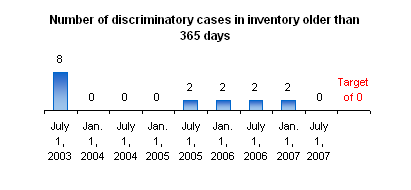 Reprisals taken against persons, who file charges, participate in
investigations or associate with persons who are disabled or are of a
different race, color, creed, religion, sexual orientation, or national
origin are unlawful. Reprisals taken against persons, who file charges, participate in
investigations or associate with persons who are disabled or are of a
different race, color, creed, religion, sexual orientation, or national
origin are unlawful.
It is an unfair practice to discriminate in the extension of credit to a
person because of race, color, creed, religion, disability, national origin,
sex, sexual orientation, marital status or public assistance status.
Discrimination is prohibited in doing business or contracting with someone
on the basis of a person's race, color, sex, sexual orientation, national
origin, or disability.
|
|
What
is the department doing?
The Department’s educational work in 2006 consisted of an annual human
rights day conference and department showcases. At the showcases, the
commissioner provided a panel of experts who trained human resource managers
in various topics of importance to employers under the provisions of the
Human Rights Act. There were also a series of community forums where the
communities throughout the state had an opportunity to hear the commissioner
as well as experts from the Department in several topics related to the act
and to discrimination as an unlawful practice.
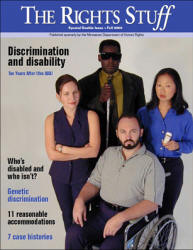 The
Department's internet web page features a
quarterly newsletter and a Commissioner's Blog and provides access to information on
human rights issues and resources. Individuals can e-mail the Department to
access information on laws and issues, and make inquiries on-line. The site
also features a human rights events calendar, a ‘questions & answer” column
called By Rights, and provides links to other human rights organizations’
web sites. The
Department's internet web page features a
quarterly newsletter and a Commissioner's Blog and provides access to information on
human rights issues and resources. Individuals can e-mail the Department to
access information on laws and issues, and make inquiries on-line. The site
also features a human rights events calendar, a ‘questions & answer” column
called By Rights, and provides links to other human rights organizations’
web sites.
The Department’s “Educate to Eliminate” campaign is a set of new initiatives
designed to:
 To develop human rights literacy in the majority of
To develop human rights literacy in the majority of
Minnesotans;
 To be a catalyst in actively endorsing and promoting
human rights by making
To be a catalyst in actively endorsing and promoting
human rights by making
human rights education a required component of our
states education
standards so than future generations of Americans will be
as knowledgeable
about their human rights as they are about their civil and constitutional
rights;
and
 To create a forum where marginalized groups can share the goal of educating
To create a forum where marginalized groups can share the goal of educating
people about their human rights in order that they may claim, promote and
defend them.
The program includes the following components:
·
“The Right Focus On…” – Quarterly
television program broadcasted in
community television which brings together
a panel of experts to discuss current
topics in the news which are covered by the Human Rights Act;
·
“This is My Home” – Human rights learning resource tool kit developed for
K-12
students and adult learners with a focus on family and
community;
·
“Training Showcase” – A showcase forum for the types
of training available that
will aid employers, business owners and service
providers in meeting their
human rights obligations and responsibilities;
·
“By Rights” – The commissioner’s column expanded into
Greater Minnesota
media outlets;
·
"As I see it" – The
Commissioner's Blog on the internet where the commissioner
discusses topics
of interest intended to spark conversation and thought about
discrimination; and
·
“International Visitors Program” – In conjunction with
the State Department, the
Department hosts visitors from around the world
who are interested in the state
of human rights in Minnesota.
What is the progress to date?
During fiscal year 2006, the Educate to Eliminate
program fulfilled all its goals.
More than 600 attended our Human Rights Day and Education Forum in December
2006;
The Department hosted 4 community forums. Attendance at each forum was 100
or more participants. The Department hosted 4 Training Showcases in
2006. The average number of participants was 45 per session. The Department and Twin Cities Public
Television started a partnership to produce a television show titled "The
Right Focus On...", to carry the human rights message.
From July to December 2006:
·
The Department implemented a tracking tool by which it is
able to determine a
close approximation of the numbers of people who have
been reached as a
result of its outreach efforts. During this period of time
the Department reached
approximately 1.3 million people.
·
The Department has hosted 3 additional forums. Average
attendance is 100
participants.
·
The Human Rights Day conference reached record setting
attendance of over
600 participants, the highest number of attendees in the
21-year history of the
conference.
·
The Department along with the University of Minnesota
Human Rights Resource
Center developed a human rights learning resource tool kit for K-12
in
conjunction with educators from around the state.
·
Part of the learning resource tool kit is a documentary
that was produced by the
Department and Twin Cities Public Television, which
has aired 3 times on the
TPT Minnesota Channel to a viewing audience of over
40,000. The documentary
will air several more times this year.
·
“By Rights” – the commissioner’s column
– was a regular
addition to the
Minnesota Counties newspaper, the Spokesman-Recorder
newspaper and the
Hmong Times newspaper.
In fiscal year 2006, the Department hosted 4 community forums to educate
Minnesotans on their rights and responsibilities under the State's Human
Rights Act. These 4 forums were held in the following communities: Brainerd,
Grand Rapids, Moorhead and Albert Lea. In addition to the forums, the
Department sponsored 4 showcases, issued 4 of the Rights Stuff newsletters and
conducted extensive outreach within all Minnesota communities. Participatio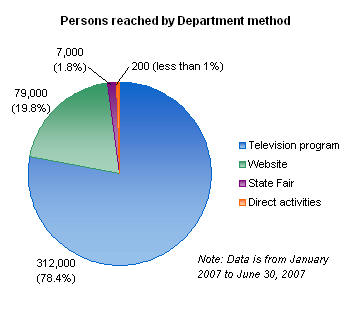 n
in over 45 separate events reached an audience of approximately 400 thousand
people. The Department also held its annual Human Rights Day Conference as
well as produced 4 videos in collaboration with SPNN-St. Paul for cable
television and the Department's website. From January 2007 to June 30, 2007,
the Department reached approximately 312,000 cable viewers with our
television educational program, 79,000 people through our website, more than
7,000 people at the State Fair and over 200 people in direct educational
activities. n
in over 45 separate events reached an audience of approximately 400 thousand
people. The Department also held its annual Human Rights Day Conference as
well as produced 4 videos in collaboration with SPNN-St. Paul for cable
television and the Department's website. From January 2007 to June 30, 2007,
the Department reached approximately 312,000 cable viewers with our
television educational program, 79,000 people through our website, more than
7,000 people at the State Fair and over 200 people in direct educational
activities.
To learn more about the “Educate to Eliminate” activities go to the
Department’s website at
www.humanrights.state.mn.us and click on
Special
Events.
|


 employment,
termination, or layoffs. Most charges of discrimination received by the
department are in the area of employment on the basis of age, sex, race or
disability. Employers of 15 or more are required to provide reasonable
accommodation for qualified employees and applicants who have disabilities.
employment,
termination, or layoffs. Most charges of discrimination received by the
department are in the area of employment on the basis of age, sex, race or
disability. Employers of 15 or more are required to provide reasonable
accommodation for qualified employees and applicants who have disabilities. access, use of trained service
animals and removal of structural barriers.
access, use of trained service
animals and removal of structural barriers. Reprisals taken against persons, who file charges, participate in
investigations or associate with persons who are disabled or are of a
different race, color, creed, religion, sexual orientation, or national
origin are unlawful.
Reprisals taken against persons, who file charges, participate in
investigations or associate with persons who are disabled or are of a
different race, color, creed, religion, sexual orientation, or national
origin are unlawful.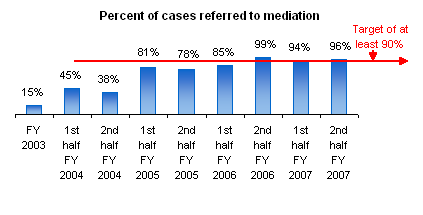 successful, early resolution allows parties to
put emotionally charged issues behind them faster than through the
traditional investigation process. Mediation allows for a more effective
handling of cases on a faster timeline.
successful, early resolution allows parties to
put emotionally charged issues behind them faster than through the
traditional investigation process. Mediation allows for a more effective
handling of cases on a faster timeline.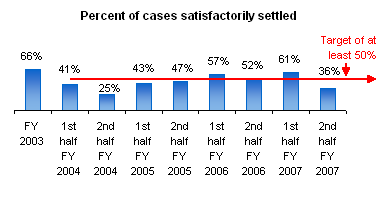 of cases were referred to
mediation. MDHR has expanded its existing internal mediation program to
accept at least 40% of cases per fiscal year. The new goal for fiscal year
2007 was to refer 90% of cases from screening to MDHR's internal mediation
program. The Department met its goal by referring 94% of cases in the first
half of fiscal year 2007 and 96% of cases in the second half of fiscal year
2007. Because mediation is
voluntary, the Department does not control settlements. However, we believe
that better education of participants on the process will enable more cases
to be satisfactorily settled.
of cases were referred to
mediation. MDHR has expanded its existing internal mediation program to
accept at least 40% of cases per fiscal year. The new goal for fiscal year
2007 was to refer 90% of cases from screening to MDHR's internal mediation
program. The Department met its goal by referring 94% of cases in the first
half of fiscal year 2007 and 96% of cases in the second half of fiscal year
2007. Because mediation is
voluntary, the Department does not control settlements. However, we believe
that better education of participants on the process will enable more cases
to be satisfactorily settled.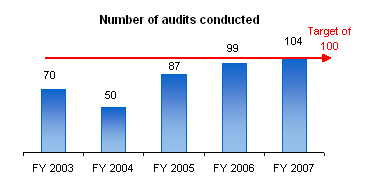 A firm or business that has employed more than 40 full-time employees on a
single working day during the past 12 months must have a certificate of
compliance to bid on or be awarded a state contract of $100,000 or more. The
certificate of compliance is issued to businesses that have an affirmative
action plan approved by the commissioner for the employment of women,
minorities and disabled persons. The Minnesota Legislature amended the Human
Rights Act in 2003 to require the Department of Human rights to charge a $75
fee for each certificate of compliance issued effective 7-1-03.
A firm or business that has employed more than 40 full-time employees on a
single working day during the past 12 months must have a certificate of
compliance to bid on or be awarded a state contract of $100,000 or more. The
certificate of compliance is issued to businesses that have an affirmative
action plan approved by the commissioner for the employment of women,
minorities and disabled persons. The Minnesota Legislature amended the Human
Rights Act in 2003 to require the Department of Human rights to charge a $75
fee for each certificate of compliance issued effective 7-1-03.
 The
Department's internet web page features a
quarterly newsletter and a Commissioner's Blog and provides access to information on
human rights issues and resources. Individuals can e-mail the Department to
access information on laws and issues, and make inquiries on-line. The site
also features a human rights events calendar, a ‘questions & answer” column
called By Rights, and provides links to other human rights organizations’
web sites.
The
Department's internet web page features a
quarterly newsletter and a Commissioner's Blog and provides access to information on
human rights issues and resources. Individuals can e-mail the Department to
access information on laws and issues, and make inquiries on-line. The site
also features a human rights events calendar, a ‘questions & answer” column
called By Rights, and provides links to other human rights organizations’
web sites. n
in over 45 separate events reached an audience of approximately 400 thousand
people. The Department also held its annual Human Rights Day Conference as
well as produced 4 videos in collaboration with SPNN-St. Paul for cable
television and the Department's website. From January 2007 to June 30, 2007,
the Department reached approximately 312,000 cable viewers with our
television educational program, 79,000 people through our website, more than
7,000 people at the State Fair and over 200 people in direct educational
activities.
n
in over 45 separate events reached an audience of approximately 400 thousand
people. The Department also held its annual Human Rights Day Conference as
well as produced 4 videos in collaboration with SPNN-St. Paul for cable
television and the Department's website. From January 2007 to June 30, 2007,
the Department reached approximately 312,000 cable viewers with our
television educational program, 79,000 people through our website, more than
7,000 people at the State Fair and over 200 people in direct educational
activities.